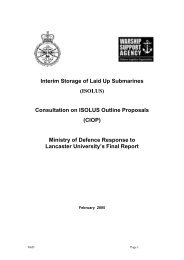Part III - Historical Survey of the Porton Down Service Volunteer ...
Part III - Historical Survey of the Porton Down Service Volunteer ...
Part III - Historical Survey of the Porton Down Service Volunteer ...
You also want an ePaper? Increase the reach of your titles
YUMPU automatically turns print PDFs into web optimized ePapers that Google loves.
• one man had 5 <strong>of</strong> 17 pairs with jitter readings over 55 µs three days after and 8 <strong>of</strong><br />
17 pairs in that range four months later.<br />
The report went on to note that a previous study, in which volunteers were exposed to GB at<br />
5 mg.min/m 3 while testing nerve agent treatment, had resulted in abnormal SFEMG readings<br />
three days after exposure [121].<br />
Two points might be made here:<br />
• First, <strong>the</strong> report <strong>of</strong> <strong>the</strong> SFEMG readings published in 1985 was a preliminary<br />
interpretation which contained some flaws. The analysis and conclusions <strong>of</strong> <strong>the</strong><br />
completed study were published in <strong>the</strong> open press in 1996 [122].<br />
• Second, SFEMG seems to have been an instance where measurement<br />
technique outstripped medical knowledge. SFEMG was extremely sensitive, so it<br />
was difficult to understand what <strong>the</strong> measurements meant [120]. No<br />
neuromuscular abnormality was detected in <strong>the</strong> clinical examination conducted<br />
on <strong>the</strong> volunteers after <strong>the</strong> experiments and before <strong>the</strong>y left <strong>Porton</strong>.<br />
Notwithstanding <strong>the</strong> second point, <strong>the</strong> volunteers involved in <strong>the</strong> study were asked to return<br />
for fur<strong>the</strong>r examinations and specialist opinion was sought. In <strong>the</strong> interim, all exposures <strong>of</strong><br />
volunteers to 15 mg.min/m 3 were prohibited in September 1984 [123]. Specialist opinion was<br />
sought from <strong>the</strong> Royal Free Hospital and National Hospitals. London Hospital agreed [124]<br />
<strong>the</strong> SFEMG findings at <strong>Porton</strong> seemed abnormal but, because <strong>of</strong> <strong>the</strong> sensitivity <strong>of</strong> <strong>the</strong><br />
technique, <strong>the</strong> practical significance <strong>of</strong> <strong>the</strong> findings was open to question.<br />
This advice was received in 1985. All human studies with GB were suspended until <strong>the</strong><br />
significance <strong>of</strong> <strong>the</strong> SFEMG changes was clarified [126]. The volunteers returned, when it was<br />
convenient to <strong>the</strong>m and <strong>the</strong>ir units, for fur<strong>the</strong>r SFEMG studies during 1985 and 1986.<br />
SFEMG studies were conducted at London Hospital and <strong>the</strong> volunteers also had eye<br />
movements checked at Queen's Square and retinal function examined at Moorfields Eye<br />
Hospital [127].<br />
By November 1986 SFEMG examinations had been completed and <strong>the</strong> changes observed<br />
after <strong>the</strong> exposure at <strong>Porton</strong> in 1984 were not apparent. It was concluded that any effect GB<br />
might have on neuromuscular transmission was reversible [121, 128]. The MC concluded in<br />
February 1987 [129] that this result posed no bar to continuing low dose GB exposures at<br />
5 mg.min/m 3 .<br />
The Medical Committee decided in March 1987 that SFEMG would be used as a screening<br />
procedure for future experiments with GB [130] and, from <strong>the</strong>n on, a careful watch seems to<br />
have been maintained on SFEMG readings. Apparently abnormal SFEMG readings were<br />
observed after exposures in 1988 and reviewed by <strong>the</strong> committee in November [131], but,<br />
because <strong>the</strong> readings "were essentially no different to those seen previously", it was decided<br />
that experiments could continue.<br />
9.6.5. Electroencephalography (EEG)<br />
A report in 1987 reviewed <strong>the</strong> toxicology <strong>of</strong> GB and GD [132]. The review was conducted by<br />
surveying <strong>Porton</strong> documents and external reports. The points made were as follows:<br />
92<br />
• from <strong>the</strong> survey, it was evident that GB and GD can produce both short-term and<br />
long-term effects at sub-lethal doses;<br />
• most <strong>of</strong> <strong>the</strong> information on symptoms following exposure to anti-ChE compounds<br />
comes from literature on poisoning due to OP insecticides. In <strong>the</strong> early work at<br />
<strong>Porton</strong> into <strong>the</strong> effect <strong>of</strong> nerve agents on man, <strong>the</strong> "emphasis was on generalised<br />
symptoms immediately following exposure, with no follow-up investigation <strong>of</strong><br />
persistent clinical signs (including psychological effects)";









